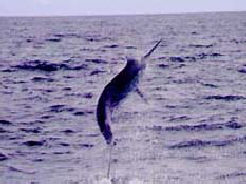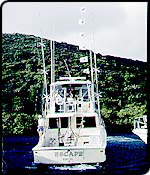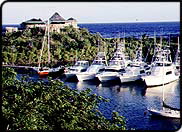|
Fat Lady's Marlin
Marlin catches off Virgin Gorda in the British Virgin Islands are a new discovery for the international sport fishing set.
by Larry Larsen
 The owners, captains and anglers aboard the nine sportfishing yachts moored quietly at the small Biras Creek marina were concerned. The
following day was the first of an international billfish tournament, and they were being forced by the tournament director to fish a relatively unknown and
unproven area nearby. What they found out on that first day, however, would set the sport fishing crowd on its ear. The owners, captains and anglers aboard the nine sportfishing yachts moored quietly at the small Biras Creek marina were concerned. The
following day was the first of an international billfish tournament, and they were being forced by the tournament director to fish a relatively unknown and
unproven area nearby. What they found out on that first day, however, would set the sport fishing crowd on its ear.
Without exception, all nine vessels fishing the South Drop of Virgin Gorda in the British Virgin Islands caught
more blue marlin than ever, anywhere. The "reluctant" discovery of a blue marlin fishery of such magnitude just 30 minutes away from the marina obviously pleased everyone.
Each afternoon of the four-day tournament was a celebration of sorts. The boats
would approach the marina with multiple marlin flags strung up on their antennas. The flags flying upside down denoted releases, but some anglers actually caught and tagged more
blues on a particular day than they had flags aboard.
The nine sportfishermen waved a total of 87 blue marlin during the Biras Creek
International Team Fishing Tournament. That's almost a ten fish average per boat for the
four days. The winning boat, the "Escape", caught and released seven blues on day one alone and looked like a Christmas tree with its flag display as it approached the resort
marina that afternoon.
The "Escape" finished the tournament with 19 blue marlin, an obvious all-time all
-tournament record for big game fishing tournaments. The boat's owner, Charley Campbell, and guest angler Doc Stewart, caught 9 and 10, respectively. While all of their tagged-and
-released blues were under the tournament-imposed size limit of 300 pounds, they lost one that was much larger. It was estimated to be over 450 pounds.
Don Stallings, owner of the "Sea Eagle," landed 11 blue marlin alone over the four days.
His five on day one was his best day ever, and he reported that his 11 that week would have made a good "season" for him many years. His wife, Billie, helped him land the first
blue marlin double in his long-time angling experience.
Doubles, Triples and More!
All of the participating boats had on doubles, and most reported triples and even quads
on their baits during the event several years ago. The fish caught off the newly-discovered South Drop ranged from 100 to 200 pounds, and only two over 300 pounds were brought
to the scales. That's a positive note for conservation and for those anglers who want to keep the discovery of the area's fishery to themselves.

The South Drop area, as it is known locally, lies a few miles off
the northeastern point of Virgin Gorda. On the map, the area lies just off Horseshoe Reef on the eastern side of Anegada, and it is
quite possibly the best blue marlin area in the Caribbean. The number of blue marlin that inhabit the area is unfathomable.
Waters there drop from 30 fathoms to over 200, and the bottom is an irregular recorder plot revealing numerous peaks and valleys.
Huge schools of flying fish are on the surface and dense "clouds" of bait hug the bottom of the South Drop. Both apparently attract the concentrations of blue marlin.
June through August are thought to be prime marlin months, but the South Drop fishery
could reveal new information. September is typically a productive month as well for blues, and one of the anglers in the tournament predicted that fishing the South Drop in late
September or October would result in the biggest blues from that area.
Blues of 800 and 900 pounds are taken just 25 miles away at the famous North Drop
area off Jost Van Dyke. To date, most of the big Virgin Island blues have come from that area and from the area fished by charters from St. Thomas in the U.S.V.I. The
mountainous Jost Van Dyke lies west of the remote island of Anegada. Those experienced now on the South Drop believe it will yield monsters in the future.
The waters off Virgin Gorda are always very clear, so the billfish there are not used to
moving in and out with the clean waters. The clarity is excellent because there are no rivers or other pollution sources that could present silt to the waters. The height of their
mountains seems to dictate the climate and the amount of rainfall. Since they are low, rain clouds pass by the BVI. Abundant semi-arid plants, such as cactus, are the norm on Virgin
Gorda and other islands in the BVI.
Other Caribbean islands with taller mountains, like Puerto Rico to the west and the French
West Indies to the south, block the moisture-laden air from passing on by. The showers fall on their rain forests as the moisture condenses. Those islands have rivers, waterfalls
and estuary areas which can dump silt into the water and influence the area's billfish waters. The BVI's just do not have similar problems.
Weathering The Marlin Bite
Most frequent showers on Virgin Gorda occur during May and then later in September
and October. While the islands may experience rain with a tropical wave, seldom do hurricanes hit the BVI. The last to hit the islands was of minimal strength. Most hurricanes
pass to the south of those isles or form after they have passed as a tropical squall or depression.
Sport fishing weather in the BVI seldom varies; it's warm year around. Daytime highs
are rarely in the 90's, and during the winter, the lowest temperatures to expect are in the low 70's. Highs then might hit 80 degrees. Water temperatures will fluctuate about 10
degrees, according to locals. They'll hit mid-70's in the coldest months and warm up to the
mid-80's at the end of the summer. It's wise for anglers to wear their fisherman's sunscreen year around.
Wind can be a factor to the smaller sportfishing boats, since the BVI gets steady trade
winds. They are predominantly out of the east and average 15 knots throughout the year. Calm days are rare, but winds exceeding 20 knots are not. Seas may average around 4 or
5 feet, and some days they will be less (2 to 3 foot) over the course of the year. Summer winds are normally calmer than those in the winter months.
 The remoteness of the islands and minimal population makes the area a great place for anglers to get away from hustle and bustle. Half the islands in
the BVI are totally uninhabited, and all of the islands' beaches are open to visitors. For those offshore anglers wanting to stretch
their legs or have a picnic lunch, there's usually an island with a scenic beach within 15 or 20 minutes from the big game action. The remoteness of the islands and minimal population makes the area a great place for anglers to get away from hustle and bustle. Half the islands in
the BVI are totally uninhabited, and all of the islands' beaches are open to visitors. For those offshore anglers wanting to stretch
their legs or have a picnic lunch, there's usually an island with a scenic beach within 15 or 20 minutes from the big game action.
Tides around Virgin Gorda are usually less than one foot, so misjudging them is not a problem for sport fishermen. There
might be more fluctuation around the new and full moon periods. Local charter captains use caution around the island of Anegada,
which lies to the north of Virgin Gorda. It's the only major isle in the BVI that is not mountainous, and has the second largest reef system in the western hemisphere surrounding it.
The reef has over 300 shipwrecks, counting both pirate vessels of old and modern craft.
The barrier reef skirting Anegada is, in fact, twice as long as the island. Other than that, there are few navigation problems in the BVI. The few hazards around are quite clear on
the charts. Although markers are few, the water is extremely clear, the islands are close together and the bottom drops off quickly away from the mountainous terrain.
Other Line Stretchers
Wahoo, often called, "billfish without bills", can be caught year round off Virgin Gorda.
Some moon phases are better than others, according to the local captains. The full moon is most productive for fooling a smart wahoo. The fish in the area average around 40
pounds but may weigh as much as 70 pounds.
Schooling dolphin weighing up to 50 pounds have been caught at numerous spots
throughout the BVI. Find water deeper than 150 feet and an angler may quickly load the boat with them. The winter months are good for finding the roving dolphin schools. Their
appearance close to the islands is influenced by winds and the moon phase, full being the best according to local anglers.
Large yellowfin tuna are often caught during the winter months. The Sea Mound, about
10 miles south of Virgin Gorda, and the South Drop, to the east of Virgin Gorda, yield yellowfins of up to 75 pounds or more. Kingfish are also numerous and are often seen free jumping.
The winter months also attract other billfish. Excellent white marlin and sailfishing occurs
through February. Sails as large as 75 pounds can be caught, and doubles are frequent then. As is the case elsewhere, ballyhoo are the preferred attraction for the smaller billfish.
For billfish of any size, Virgin Gorda is hard to top!
|